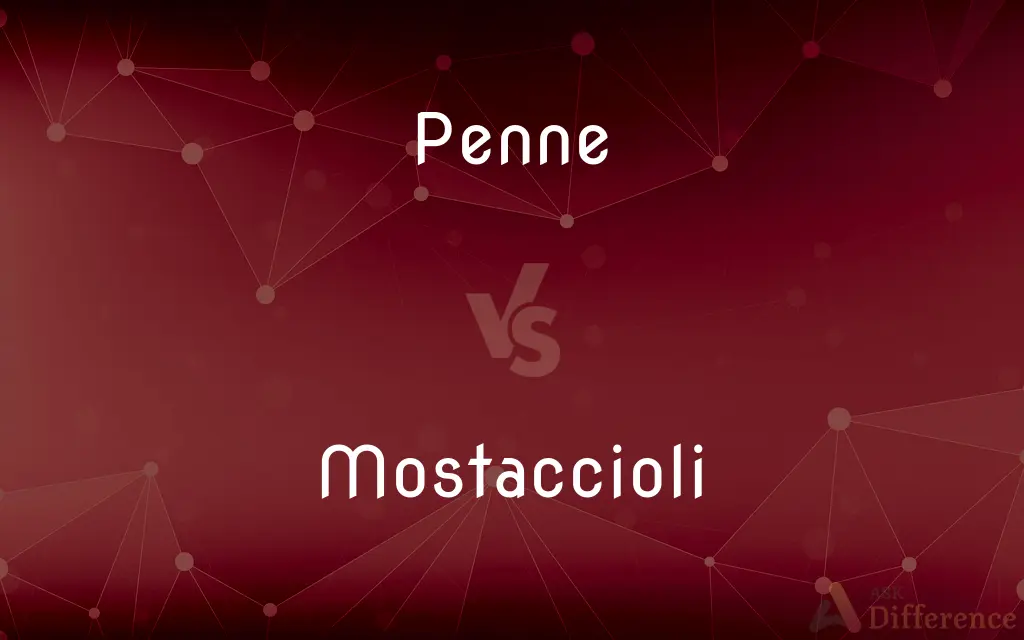Penne vs. Mostaccioli — What's the Difference?
By Maham Liaqat & Urooj Arif — Updated on March 6, 2024
Penne are tube-shaped pasta with angled cuts, while mostaccioli resembles penne but often has smooth sides.

Difference Between Penne and Mostaccioli
Table of Contents
ADVERTISEMENT
Key Differences
Penne pasta is distinguished by its cylindrical shape, with ends cut at a sharp angle, similar to the quill of an old-style ink pen, which is where its name derives from. This type of pasta typically comes in two varieties: penne lisce (smooth) and penne rigate (ridged). Mostaccioli, on the other hand, is very similar to penne in shape and size but is traditionally smooth and lacks the ridges that are often found on penne rigate. Mostaccioli ends may also be cut at a less sharp angle compared to penne.
While both penne and mostaccioli are used in various pasta dishes, the texture and surface of the pasta can affect how sauce adheres to it. Penne rigate, with its ridges, tends to hold onto sauces better, providing a richer flavor in each bite. Mostaccioli, with its smooth surface, might not hold sauce as well but is still popular for its pleasing texture and compatibility with lighter sauces or baked pasta dishes.
Penne is arguably more widely recognized and used in a broader array of dishes worldwide. It's versatile, making it suitable for a range of sauces, from light olive oil-based to hearty meat sauces. Mostaccioli is often associated with specific types of dishes, such as baked ziti-style recipes, where it's layered with cheese, sauce, and sometimes meat, then baked.
In terms of origin, both penne and mostaccioli have roots in Italian cuisine, but penne has gained international popularity and is readily available in supermarkets around the world. Mostaccioli may not be as widely known outside of regions with a strong Italian culinary influence, making it a more specialized choice for those looking to recreate specific Italian or Italian-American dishes.
Despite these differences, penne and mostaccioli can often be used interchangeably in recipes, depending on personal preference and the desired outcome of the dish. The choice between penne and mostaccioli might come down to the texture preference or the specific requirements of a recipe, as the two types of pasta are similar enough in size and shape to substitute for one another in many dishes.
ADVERTISEMENT
Comparison Chart
Shape
Tube-shaped with angled ends.
Similar to penne but often with straighter cuts.
Texture
Comes in ridged (penne rigate) and smooth (penne lisce).
Typically smooth, without ridges.
Sauce Adherence
Ridges help sauce cling to the pasta.
Smooth surface may result in lighter sauce coating.
Usage
Versatile for various sauces and dishes.
Often used in baked dishes or with lighter sauces.
Availability
Widely recognized and available internationally.
Less commonly known outside Italian culinary circles.
Compare with Definitions
Penne
Tube-shaped pasta with ends cut at an angle.
She served penne with a spicy arrabbiata sauce.
Mostaccioli
Resembles penne but is often smoother and less angled.
Mostaccioli was the pasta of choice for the baked ziti dish.
Penne
Can be used interchangeably with mostaccioli in many recipes.
She substituted penne for mostaccioli in her grandmother’s recipe.
Mostaccioli
Smooth surface, typically without ridges.
The smooth texture of mostaccioli pairs well with light tomato sauces.
Penne
Suitable for a wide range of sauces.
The chef recommended penne for the rich Bolognese sauce.
Mostaccioli
Less widely recognized outside of Italian cuisine.
Finding mostaccioli in a regular grocery store can sometimes be a challenge.
Penne
Available in ridged and smooth varieties.
For the casserole, he preferred using penne rigate for its texture.
Mostaccioli
A specific choice for certain traditional dishes.
The recipe called for mostaccioli, reflecting its regional Italian origins.
Penne
Popular in various cuisines around the world.
Penne has become a staple in both traditional and modern pasta dishes.
Mostaccioli
Commonly used in baked pasta dishes.
For the potluck, he prepared a cheesy mostaccioli bake.
Penne
Penne (Italian: [ˈpenːe]) is an extruded type of pasta with cylinder-shaped pieces, their ends cut at an angle. Penne is the plural form of the Italian penna (meaning feather but pen as well), deriving from Latin penna (meaning "feather" or "quill"), and is a cognate of the English word pen.
Mostaccioli
Pasta in short tubes with slanted ends.
Penne
Pasta in small short tubes with diagonally cut ends.
Mostaccioli
Pasta somewhat resembling little moustaches
Penne
A type of short, diagonally cut pasta.
Mostaccioli
A type of penne pasta which resembles ziti.
Penne
Pasta in short tubes with diagonally cut ends
Common Curiosities
Can I use penne instead of mostaccioli in a recipe?
Yes, penne can often be used as a substitute for mostaccioli, especially in dishes where the pasta's texture and sauce adherence are not critical factors.
Is mostaccioli or penne better for baked pasta dishes?
Mostaccioli is traditionally preferred for baked dishes, though penne, particularly penne rigate, can also be used effectively.
What makes mostaccioli different from penne lisce?
While both are smooth, mostaccioli tends to have a straighter cut and is traditionally used in specific dishes like baked pasta.
Why choose penne rigate over mostaccioli for some sauces?
Penne rigate’s ridges help sauce cling to the pasta better, making it suitable for thicker, meatier sauces.
Where did penne and mostaccioli originate?
Both pasta types have their roots in Italian cuisine, with penne being more widely known and used across various culinary traditions.
How do I choose between penne and mostaccioli?
The choice may depend on personal texture preferences, the specific recipe requirements, or the desired sauce adherence.
Are there dishes that specifically call for mostaccioli?
Yes, certain traditional Italian or Italian-American dishes, like baked ziti, may specifically call for mostaccioli due to its texture and how it pairs with other ingredients.
Can the shape of the pasta really impact the taste of a dish?
While not directly affecting taste, the pasta’s shape can influence the texture and how well the pasta integrates with the sauce, potentially altering the overall flavor experience.
Is penne more popular worldwide than mostaccioli?
Yes, penne is more widely recognized and available globally, making it a more common choice in a variety of dishes.
How should I cook penne or mostaccioli for the best results?
Both pasta types should be cooked in boiling salted water until al dente, or firm to the bite, following the package’s instructions for timing.
Share Your Discovery

Previous Comparison
Concept vs. Precept
Next Comparison
Institute vs. InstitutionAuthor Spotlight
Written by
Maham LiaqatCo-written by
Urooj ArifUrooj is a skilled content writer at Ask Difference, known for her exceptional ability to simplify complex topics into engaging and informative content. With a passion for research and a flair for clear, concise writing, she consistently delivers articles that resonate with our diverse audience.















































